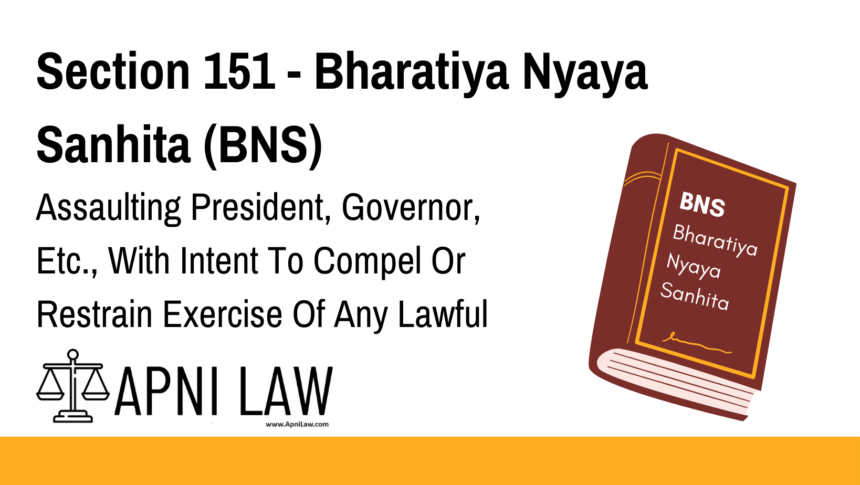Code – Section 151 BNS
Whoever, with the intention of inducing or compelling the President of India, or
Governor of any State, to exercise or refrain from exercising in any manner any of the lawful
powers of such President or Governor, assaults or wrongfully restrains, or attempts wrongfully
to restrain, or overawes, by means of criminal force or the show of criminal force, or attempts
so to overawe, such President or Governor, shall be punished with imprisonment of either
description for a term which may extend to seven years, and shall also be liable to fine.
Explanation of Section 151 BNS
Section 151 of the Bharatiya Nyaya Sanhita, 2023 (BNS) deals with criminal acts committed against the President of India or the Governor of any State with the intent of influencing their lawful powers. This section is crucial to maintaining the dignity and independence of constitutional authorities.
Key Elements of Section 151 BNS
-
Target of the Offense: The law specifically protects the President of India and the Governors of States.
-
Intent: The offender must have the intent to compel or restrain the President or Governor from exercising their legal powers.
-
Forms of Criminal Acts:
-
Assault: Any act of physical harm or an attempt to cause harm.
-
Wrongful Restraint: Preventing movement unlawfully.
-
Overawing by Criminal Force: Using threats, force, or intimidation to influence their decisions.
-
-
Punishment:
-
Imprisonment: Up to seven years.
-
Fine: The offender is also liable to pay a monetary penalty.
-
This section ensures that the highest constitutional authorities remain free from coercion, pressure, or threats in the execution of their duties.
Illustrations of Section 151 BNS
Example 1: Physical Assault on a Governor
A group of political activists, upset over a policy decision, physically obstructs the Governor’s convoy and attempts to restrain them from reaching a government function. This act falls under Section 151 BNS, as it aims to influence the Governor’s lawful duties.
Example 2: Threats Against the President
A person issues a public threat of violence against the President of India to force them to veto a bill. Even if no physical action follows, the mere act of intimidation using criminal force can invoke Section 151.
Example 3: Protest Turns Violent
During a protest, a mob tries to enter the Governor’s official residence and uses force against security personnel to compel the Governor to step down. This would be a clear violation of Section 151 BNS.
Common Questions and Answers on Section 151 BNS
1. Why does the law provide special protection to the President and Governors?
These constitutional authorities must act without fear or external pressure. This law ensures their decisions remain independent.
2. Does this section apply to verbal threats?
Mere verbal threats may not be enough unless they include the use or threat of criminal force.
3. What is the difference between wrongful restraint and overawing by force?
-
Wrongful Restraint: Physically preventing someone from moving freely.
-
Overawing by Force: Using intimidation or threats to influence decisions.
4. Can a protest be charged under Section 151 BNS?
Peaceful protests are not punishable under this section. However, if protestors assault, restrain, or threaten with criminal force, they may be charged.
5. What other sections of BNS might be relevant in such cases?
-
Section 152 BNS – Assaulting a public servant in execution of duty.
-
Section 153 BNS – Unlawful assembly with intent to commit an offense.
-
Section 383 BNS – Criminal intimidation.
Conclusion
Section 151 BNS plays a vital role in protecting the highest constitutional authorities from coercion, physical harm, and intimidation. It ensures that the President of India and Governors can exercise their duties freely, without fear of unlawful influence.
For more legal insights, visit ApniLaw today! 🚀








